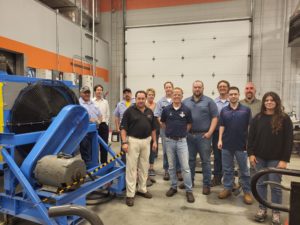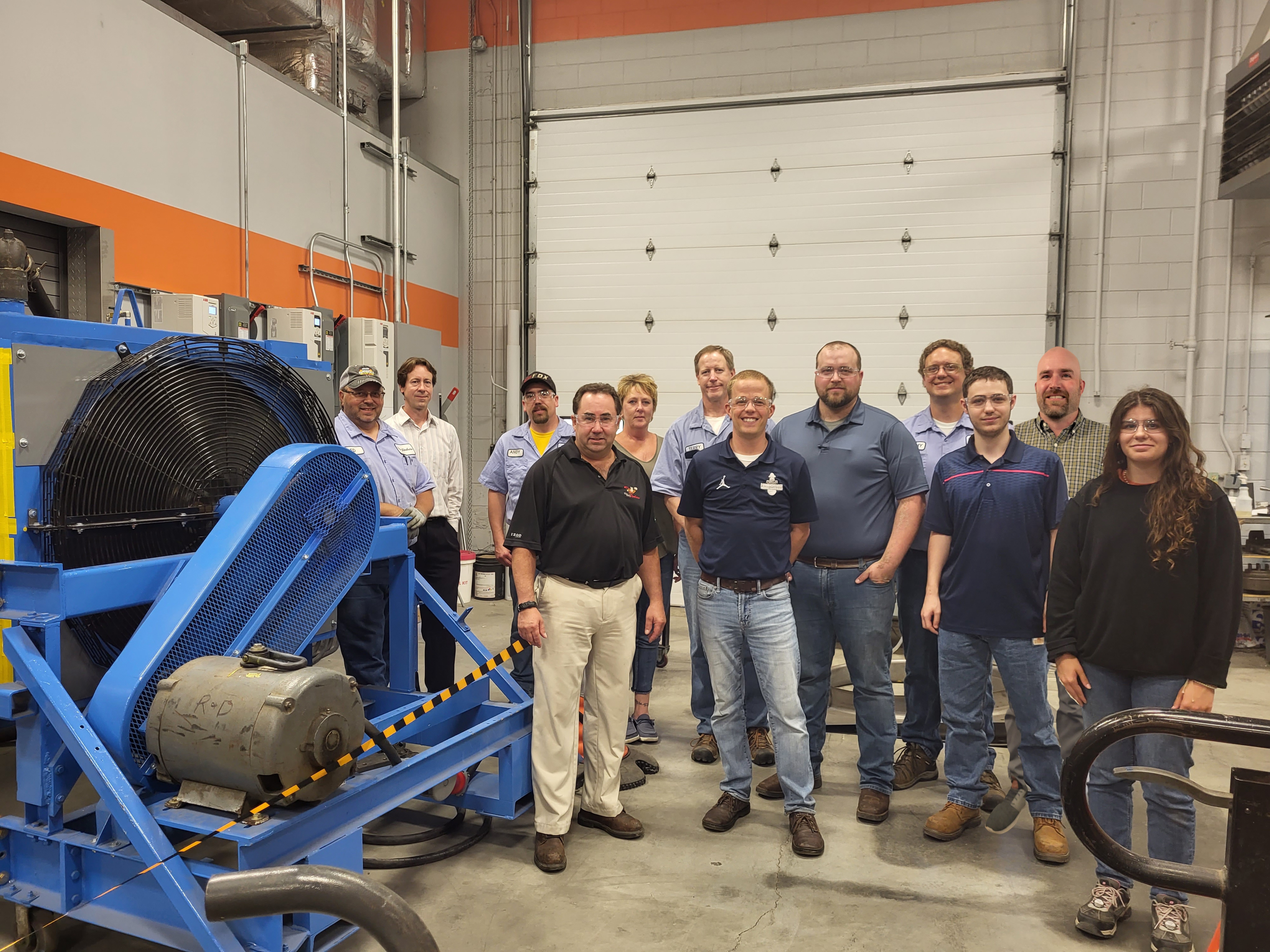Every day, the engineers at L&M Radiator are identifying and developing new solutions to meet the cooling needs of businesses operating around the world. Because wherever there is machinery, whether it’s a heavy-duty vehicle hauling or moving mountains of minerals to processing plants using machinery that could overheat, there’s an opportunity for Mesabi heat exchangers, radiators and coolers to help engines run better, run longer and run cleaner.
The responsibility for innovating solutions to meet those needs rests with L&M Radiator’s research and development team, led by Aaron Morgan, Research and Development Manager.
At L&M Radiator, the R&D team is constantly on the hunt to harness the core cooling technology of Mesabi heat exchangers, which have gained a legendary reputation for their reliability and durability over the past 65 years. Used on every continent in the world except Antarctica, industries such as mining and oil and gas rely on Mesabi heat exchangers to perform in some of the world’s most extreme conditions, from sub-zero temperatures (-60 below zero Fahrenheit) to extreme heat (130 degrees Fahrenheit).
Always looking forward, the L&M Radiator team seeks to develop cooling solutions to meet the challenges of the future, such as the use of utility-scale battery storage that will be needed to store energy produced by solar and wind power; battery-powered heavy-duty equipment (mining haul trucks, dozers and excavators), hydrogen fuel-cell powered heavy-duty equipment and much more.
“There’s always more to innovate – more ways to improve our current products and even create new applications,” Morgan said. “I’ve been doing this for a while and as an engineer, I am still surprised by the challenges we’re asked to solve. As the market is heading toward new types of energy, we will be pioneering new solutions for quite some time.”
Preventing Downtime, Now and in the Future
Regardless of what changes may come for the L&M Radiator team the challenge often boils down to five key issues:
- Machinery that is subject to excessive vibration;
- Machinery that operates in extreme heat or cold;
- Machinery that’s subject to excessive conditions such as dust, contaminants, corrosion;
- Machinery that needs to be repaired on the spot; and
- Machinery that needs to be cooled to a certain temperature to optimize operating efficiencies.
“I think there’s a misconception that haul trucks and other heavy-duty equipment powered by batteries or hydrogen fuel cells won’t need coolers,” said Morgan. “The truth is, they will definitely need coolers to operate at their peak performance – just like today’s diesel engines need coolers to operate smoothly.”
At the end of the day regardless of whatever new technology is used to power machinery, L&M Radiator’s R&D team still faces the primary challenge of preventing downtime.
“When we come up with a new type of heat exchanger tube, we have to figure out how we’re going to make it, so we have to design and build a piece of equipment to perform that function,” Morgan said. “Most of the equipment that is in our tubing department has been built by the R&D department.”
Composed of a dozen people whose jobs range from laboratory manager to machinists, engineers and assemblers, the L&M Radiator R&D team attacks a new problem like a person who is trying to solve a 1,000-piece puzzle. The R&D role is one that requires a problem-solving perspective, even down to the finest details, such as exploring seal material for tubing.
“All of our tubes are individually mounted in rubber seals and that allows them to expand and contract with temperature,” Morgan said. “It isolates them from vibration, but the rubber material needs to be durable and operate in both extreme cold and extreme heat; it’s not just going to the hardware store and buying an O-ring, there’s a lot more to it than that.”
Preparing for a Technology Shift
In working with customers around the world, the transition from combustion engines that rely upon fossil fuels to new forms of engine technologies is no longer in doubt. It is happening, it is building momentum, and L&M Radiator’s R&D team will have heat exchange solutions to meet the needs of the future.
“Our team is constantly scouting new engine technologies,” Morgan said. “Right now, we’re seeing the early stages of battery-powered systems for heavy-duty equipment.”
Historically, coolant for internal combustion engines runs between 150-230° F. Ambient air is used reduce this temperature by 10 to 30 degrees. With battery-powered vehicles, L&M customers want their coolant to run in the 70-80° F range.
“But if it’s 80 degrees out, you can’t cool something down to 70 with a normal radiator because heat flows from hot to cold, so we are developing chilling systems where we’ll use a refrigerant to cool the working fluid,” Morgan said.
“It’s not clear if combustion engines for heavy-duty equipment will ever fully go away, but we’re anticipating that they will be replaced to some extent by new technology, said Morgan, “and we will be ready with new solutions.”
Cutting Emissions Through the Hydrogen Fuel Cell Market
Morgan and the L&M Radiator Research and Development team are preparing for what many consider the next step of the global energy transition after current battery-powered technologies are implemented — the hydrogen economy.
In a hydrogen-fuel cell, hydrogen is converted directly into electricity with high efficiency and low power losses. Within the oil & gas and mining industries, hydrogen fuel cell technology will help power heavy-duty equipment.
“We already have products that work on hydrogen-powered equipment,” Morgan said. “The biggest industry challenge we face with hydrogen-fuel cells is that certain metals can’t be used in the cooling systems. For example, copper does not pair well with hydrogen fuel cells.” R&D is currently developing tubes made of materials that are compatible with this environment.
“While it takes patience, it’s great to watch a product go through all the development stages and become successful,” Morgan said.
Rigorously Evaluating Efficiency
As a team, the L&M Radiator R&D Department plans out yearly corporate goals to increase profitability and to emphasize lean manufacturing.
“L&M Radiator’s leadership team does a great job of evaluating cost efficiency plant-wide,” Morgan said. “We’ve streamlined our labor usage and material-wise we’re always evaluating the cost-benefit of each material and its capabilities.”
L&M Radiator’s all-aluminum radiator tube is a stand-out product that came as a direct result of evaluating production and material costs. Plus, Morgan added that a great selling feature of aluminum is that it is lighter than its copper counterpart, so the resulting radiator weighs less, and a haul truck can move more ore.
L&M Radiator has more than a million hours of run time with radiators comprised of these tubes on trucks out in the field.
“We’re the Cadillac of radiators and that comes at a price premium,” Morgan said. “But we diligently work with our customers to meet their needs and explore all of our material options to remain competitive in the market.”
Building a Career at L&M Radiator
For Morgan, building his career at L&M Radiator has supported him and his family with great benefits and lots of opportunity for career growth. On a community level, he also appreciates the beauty and outdoor activities that the Mesabi Iron Range has to offer.
“I wanted to raise our twins here, near the place where I grew up (Aurora, Minnesota) and not in a big city,” Morgan said. “I live on a lake and spend my summers water skiing. And in the winter, I enjoy downhill skiing at the nearby Giant’s Ridge ski area.”
Morgan believes the L&M Radiator Research and Development Department will continue to meet the needs of customers around the world and remain a leader in innovation for new alternative energy sources and building products – whether that be cooling batteries, fuel cells or something new yet to be discovered.
“As an engineer, I am still surprised at the new problems our industry faces, and I see how our products face different settings and challenges in all types of terrains and climates around the world,” Morgan said. “The best part of my job is finding out how to overcome these challenges and problems and implement relevant solutions that shape our industry.”

